VisME: Visual Microsaccades Explorer
Abstract
:Introduction

Methods
Background to Microsaccade Detection
System Requirements
- explore microsaccades in the context of the entire eye tracking data in time and space.
- explore the relationship between space and time for microsaccades.
- explore microsaccadic properties.
- explore individuals and groups of participants.
- explore the location of microsaccades within fixations.
- change parameters for microsaccade detection.
- study statistical values when changing parameters.
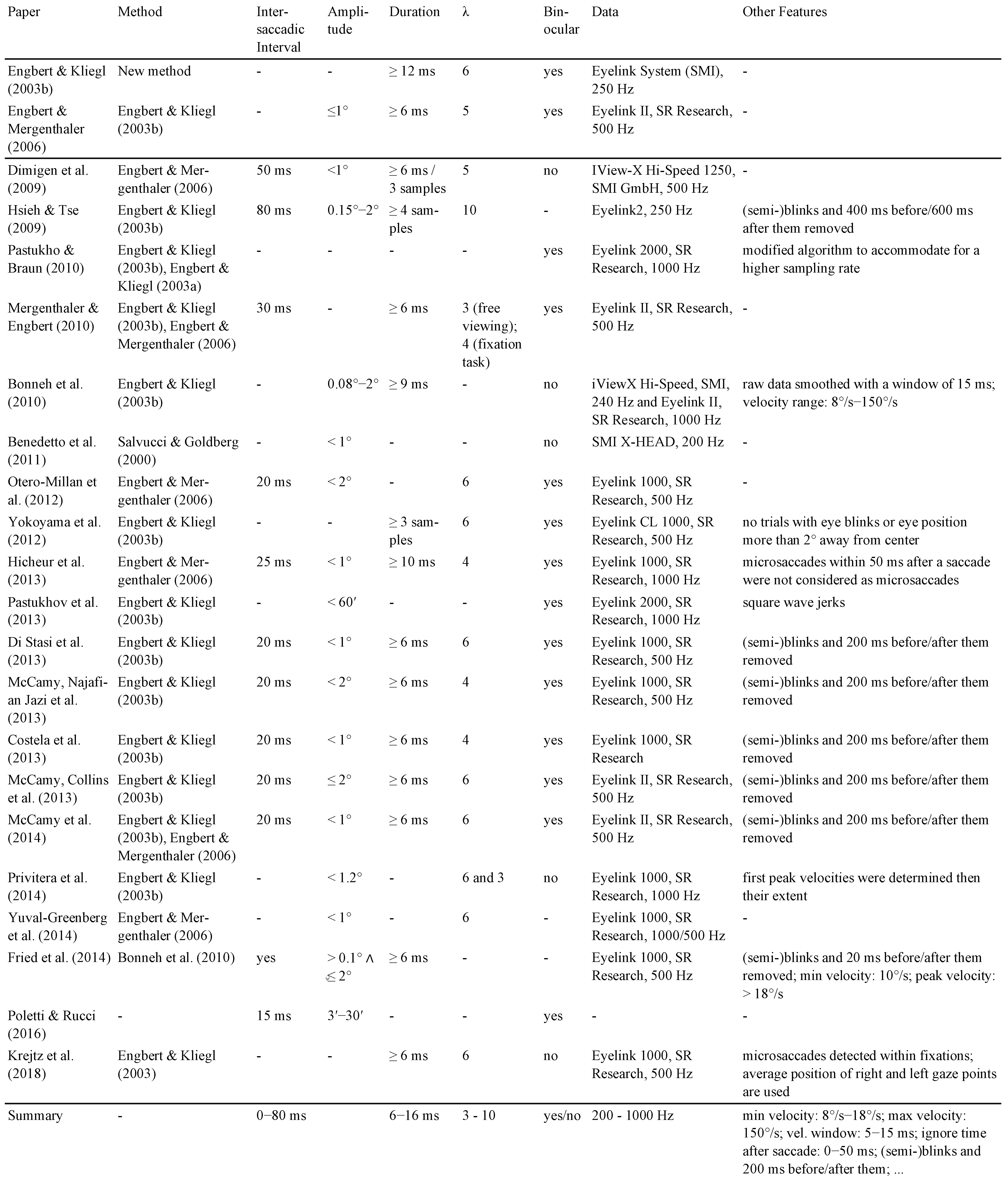 |
- differentiate between microsaccades and similar eye movements.
- explore the influence of fixation filters on microsaccades.
- explore the relationship between microsaccades and test conditions.
- integrate VisME into existing analysis pipelines.
Visual Analytics System
Eye Movement Filters
- λ for the velocity threshold
- minimum and maximum duration
- minimum and maximum amplitude
- minimum and maximum peak velocity
- velocity window size
- time being ignored at beginning/end of fixations (e.g., to ignore glissades)
- time being ignored after a microsaccade, i.e. minimum inter-saccadic interval (to ignore over-shoots)
- time being ignored before/after missing data
- monocular or binocular microsaccades
Visualizations
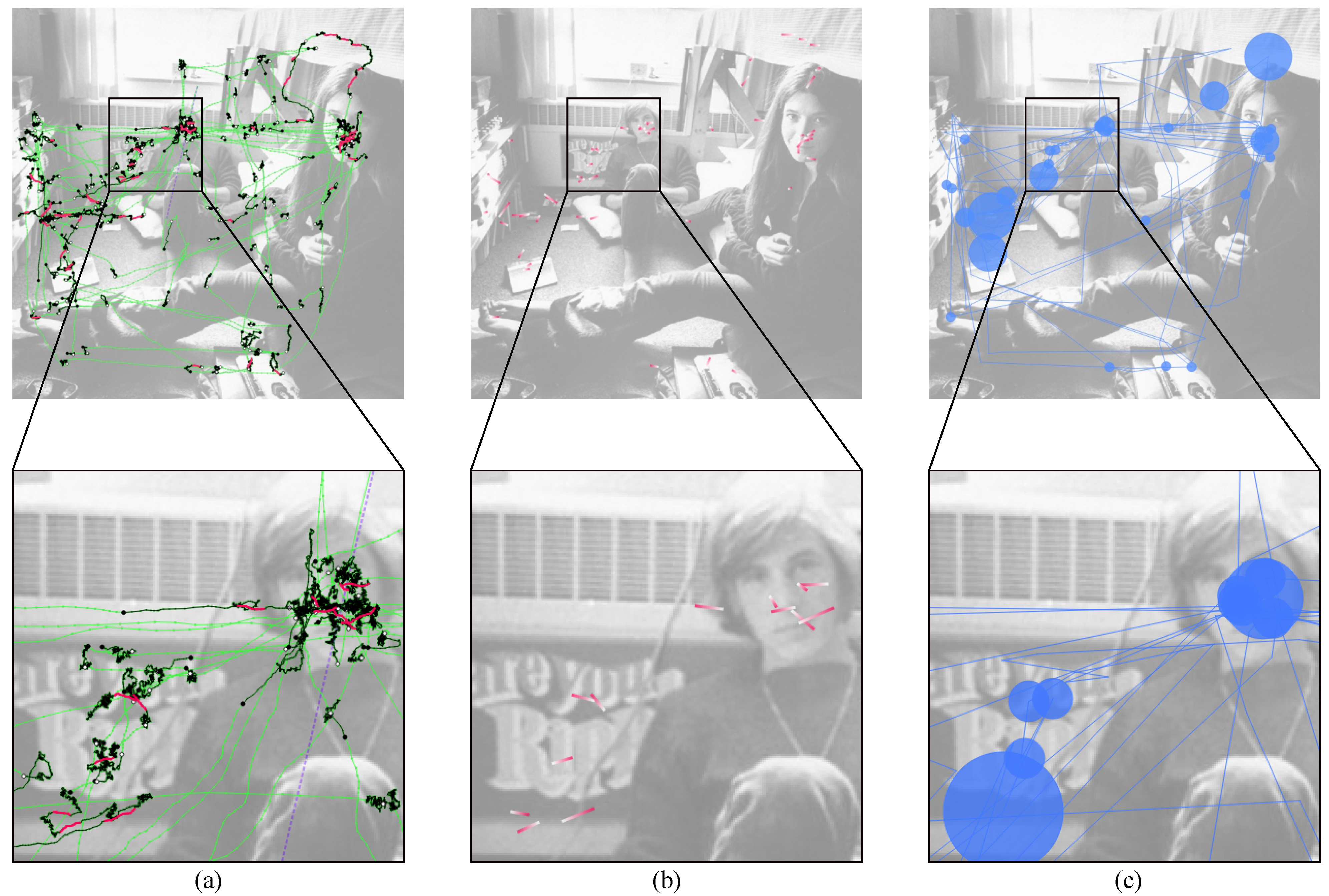

Interaction Techniques
Data Import and Export
Implementation Details
Results
Eye Movement Data Set
Case Study
Usability Study
Discussion
Acknowledgments
Conflicts of Interest
References
- Abadi, R. V., and E. Gowen. 2004. Characteristics of saccadic intrusions. Vision Research 44, 23: 2675–2690. [Google Scholar] [CrossRef] [PubMed]
- Andersson, R., L. Larsson, K. Holmqvist, M. Stridh, and M. Nyström. 2017. One algorithm to rule them all? An evaluation and discussion of ten eye movement event-detection algorithms. Behavior Research Methods 49, 2: 616–637. [Google Scholar] [CrossRef] [PubMed]
- Andrienko, G., N. Andrienko, M. Burch, and D. Weiskopf. 2012. Visual analytics methodology for eye movement studies. IEEE Transactions on Visualization and Computer Graphics 18, 12: 2889–2898. [Google Scholar] [CrossRef] [PubMed]
- Bahill, A. T., M. R. Clark, and L. Stark. 1975. Glissades–eye movements generated by mismatched components of the saccadic motoneuronal control signal. Mathematical Biosciences 26, 3: 303–318. [Google Scholar] [CrossRef]
- Bellet, M. E., J. Bellet, H. Nienborg, Z. M. Hafed, and P. Berens. 2018. Human-level saccade detection performance using deep neural networks. Journal of Neurophysiology 121, 2: 646–661. [Google Scholar] [CrossRef]
- Benedetto, S., M. Pedrotti, and B. Bridgeman. 2011. Microsaccades and exploratory saccades in a naturalistic environment. Journal of Eye Movement Research 4, 2. [Google Scholar] [CrossRef]
- Blascheck, T., K. Kurzhals, M. Raschke, M. Burch, D. Weiskopf, and T. Ertl. 2017. Visualization of eye tracking data: A taxonomy and survey. Computer Graphics Forum 36, 8: 260–284. [Google Scholar] [CrossRef]
- Blignaut, P. 2009. Fixation identification: The optimum threshold for a dispersion algorithm. Attention, Perception, & Psychophysics 71, 4: 881–895. [Google Scholar] [CrossRef]
- Bonneh, Y. S., T. H. Donner, D. Sagi, M. Fried, A. Cooperman, D. J. Heeger, and A. Arieli. 2010. Motion-induced blindness and microsaccades: Cause and effect. Journal of Vision 10, 14: 22, 1–15. [Google Scholar] [CrossRef]
- Brooke, J. 1996. SUS-A quick and dirty usability scale. Usability Evaluation in Industry 189, 194: 4–7. [Google Scholar]
- Burch, M., L. Chuang, A. Duchowski, W. Daniel, and R. Groner. 2018. Eye tracking and visualization. Introduction to the special thematic issue. Journal of Eye Movement Research 10, 5. [Google Scholar] [CrossRef] [PubMed]
- Chen, C., H. Hou, Z. Hu, and S. Liu. 2012. An illuminated path: The impact of the work of Jim Thomas. In Expanding the Frontiers of Visual Analytics and Visualization. Edited by J. Dill, R. Earnshaw, D. Kasik, J. Vince and P. C. Wong. London: Springer, pp. 9–30. [Google Scholar] [CrossRef]
- Costela, F. M., M. B. McCamy, S. L. Macknik, J. Otero-Millan, and S. Martinez-Conde. 2013. Microsaccades restore the visibility of minute foveal targets. PeerJ 1: e119. [Google Scholar] [CrossRef] [PubMed]
- Deubel, H., and B. Bridgeman. 1995. Perceptual consequences of ocular lens overshoot during saccadic eye movements. Vision Research 35, 20: 2897–2902. [Google Scholar] [CrossRef]
- Di Stasi, L. L., M. B. McCamy, A. Catena, S. L. Macknik, J. J. Cañas, and S. Martinez-Conde. 2013. Microsaccade and drift dynamics reflect mental fatigue. European Journal of Neuroscience 38, 3: 2389–2398. [Google Scholar] [CrossRef]
- Dimigen, O., M. Valsecchi, W. Sommer, and R. Kliegl. 2009. Human microsaccade-related visual brain responses. Journal of Neuroscience 29, 39: 12321–12331. [Google Scholar] [CrossRef]
- Engbert, R., and R. Kliegl. 2003a. Binocular coordination in microsaccades. In The Mind’s Eye: Cognitive and Applied Aspects of Eye Movement Research. Edited by J. Hyönä, R. Radach and H. Deubel. Amsterdam: North-Holland, pp. 103–117. [Google Scholar] [CrossRef]
- Engbert, R., and R. Kliegl. 2003b. Microsaccades uncover the orientation of covert attention. Vision Research 43, 9: 1035–1045. [Google Scholar] [CrossRef]
- Engbert, R., and K. Mergenthaler. 2006. Microsaccades are triggered by low retinal image slip. Proceedings of the National Academy of Sciences 103, 18: 7192–7197. [Google Scholar] [CrossRef]
- Engbert, R., P. Sinn, K. Mergenthaler, and H. Trukenbrod. 2015. Microsaccade Toolbox. Available online: http://read.psych.uni-potsdam.de/attachments/article/140/MS_Toolbox_R.zip.
- Ericsson, K. A., and H. A. Simon. 1993. Protocol Analysis. Cambridge, MA: MIT Press. [Google Scholar]
- Fried, M., E. Tsitsiashvili, Y. S. Bonneh, A. Sterkin, T. Wygnanski-Jaffe, T. Epstein, and U. Polat. 2014. ADHD subjects fail to suppress eye blinks and microsaccades while anticipating visual stimuli but recover with medication. Vision Research 101: 62–72. [Google Scholar] [CrossRef]
- Gao, Y., and B. A. Sabel. 2017. Microsaccade dysfunction and adaptation in hemianopia after stroke. Restorative Neurology and Neuroscience 35, 4: 365–376. [Google Scholar] [CrossRef]
- Greene, M. R., T. Liu, and J. M. Wolfe. 2012. Reconsidering Yarbus: A failure to predict observers’ task from eye movement patterns. Vision Research 62: 1–8. [Google Scholar] [CrossRef]
- Hafed, Z. M., and J. J. Clark. 2002. Microsaccades as an overt measure of covert attention shifts. Vision Research 42, 22: 2533–2545. [Google Scholar] [CrossRef] [PubMed]
- Hermens, F., and R. Walker. 2010. What determines the direction of microsaccades? Journal of Eye Movement Research 3, 4. [Google Scholar] [CrossRef]
- Hicheur, H., S. Zozor, A. Campagne, and A. Chauvin. 2013. Microsaccades are modulated by both attentional demands of a visual discrimination task and background noise. Journal of Vision 13, 13: 18, 1–20. [Google Scholar] [CrossRef]
- Holmqvist, K., M. Nyström, R. Andersson, R. Dewhurst, H. Jarodzka, and J. Van de Weijer. 2011. Eye Tracking: A Comprehensive Guide to Methods and Measures. New York: Oxford University Press. [Google Scholar]
- Hsieh, P.-J., and P. U. Tse. 2009. Microsaccade rate varies with subjective visibility during motion-induced blindness. PLOS ONE 4, 4: 1–9. [Google Scholar] [CrossRef]
- Karsh, R., and F. W. Breitenbach. 1983. Looking at looking: The amorphous fixation measure. In Eye Movements and Psychological Functions: International Views. Edited by R. Groner, C. Menz, D. F. Fisher and R. A. Monty. Lawrence Erlbaum Assoc Incorporated: pp. 53–64. [Google Scholar]
- Keim, D., F. Mansmann, J. Schneidewind, J. Thomas, and H. Ziegler. 2008. Visual analytics: Scope and challenges. In Visual Data Mining: Theory, Techniques and Tools for Visual Analytics. Edited by S. J. Simoff, M. H. Böhlen and A. Mazeika. Berlin, Heidelberg: Springer, pp. 76–90. [Google Scholar] [CrossRef]
- Krejtz, K., A. T. Duchowski, A. Niedzielska, C. Biele, and I. Krejtz. 2018. Eye tracking cognitive load using pupil diameter and microsaccades with fixed gaze. PLOS ONE 13, 9: e0203629. [Google Scholar] [CrossRef]
- Kurzhals, K., and D. Weiskopf. 2013. Space-time visual analytics of eye-tracking data for dynamic stimuli. IEEE Transactions on Visualization and Computer Graphics 19, 12: 2129–2138. [Google Scholar] [CrossRef]
- Laubrock, J., R. Engbert, and R. Kliegl. 2005. Microsaccade dynamics during covert attention. Vision Research 45, 6: 721–730. [Google Scholar] [CrossRef]
- Laubrock, J., R. Kliegl, M. Rolfs, and R. Engbert. 2010. When do microsaccades follow spatial attention? Attention. Perception, & Psychophysics 72, 3: 683–694. [Google Scholar] [CrossRef]
- Liversedge, S., I. Gilchrist, and S. Everling. 2011. The Oxford Handbook of Eye Movements. New York: Oxford University Press. [Google Scholar] [CrossRef]
- Lowet, E., B. Gomes, K. Srinivasan, H. Zhou, R. J. Schafer, and R. Desimone. 2018. Enhanced neural processing by covert attention only during microsaccades directed toward the attended stimulus. Neuron 99, 1: 207–214.e3. [Google Scholar] [CrossRef]
- Malinov, I. V., J. Epelboim, A. N. Herst, and R. M. Steinman. 2000. Characteristics of saccades and vergence in two kinds of sequential looking tasks. Vision Research 40, 16: 2083–2090. [Google Scholar] [CrossRef]
- Martinez-Conde, S., S. L. Macknik, X. G. Troncoso, and D. H. Hubel. 2009. Microsaccades: a neurophysiological analysis. Trends in Neurosciences 32, 9: 463–475. [Google Scholar] [CrossRef] [PubMed]
- McCamy, M. B., Collins, N., Otero-Millan, J., Al-Kalbani, M., Macknik, S. L., Coakley, D., ... Martinez-Conde, S. 2013. Simultaneous recordings of ocular microtremor and microsaccades with a piezoelectric sensor and a video-oculography system. PeerJ 1: e14. [Google Scholar] [CrossRef] [PubMed]
- McCamy, M. B., A. Najafian Jazi, J. Otero-Millan, S. L. Macknik, and S. Martinez-Conde. 2013. The effects of fixation target size and luminance on microsaccades and square-wave jerks. PeerJ 1: e9. [Google Scholar] [CrossRef]
- McCamy, M. B., J. Otero-Millan, L. L. Di Stasi, S. L. Macknik, and S. Martinez-Conde. 2014. Highly informative natural scene regions increase microsaccade production during visual scanning. Journal of Neuroscience 34, 8: 2956–2966. [Google Scholar] [CrossRef]
- McCamy, M. B., J. Otero-Millan, R. J. Leigh, S. A. King, R. M. Schneider, S. L. Macknik, and S. Martinez-Conde. 2015. Simultaneous recordings of human microsaccades and drifts with a contemporary video eye tracker and the search coil technique. PLOS ONE 10, 6: 1–20. [Google Scholar] [CrossRef]
- Mergenthaler, K., and R. Engbert. 2010. Microsaccades are different from saccades in scene perception. Experimental Brain Research 203, 4: 753–757. [Google Scholar] [CrossRef] [PubMed]
- Mihali, A., B. Opheusden, and W. J. Ma. 2017. Bayesian microsaccade detection. Journal of Vision 17, 1: 13, 1–23. [Google Scholar] [CrossRef]
- Munz, T. 2019. VisME software v1.2. [Google Scholar] [CrossRef]
- Munzner, T. 2009. A nested model for visualization design and validation. IEEE Transactions on Visualization and Computer Graphics 15, 6: 921–928. [Google Scholar] [CrossRef]
- Nosek, B. A., Alter, G., Banks, G. C., Borsboom, D., Bowman, S. D., Breckler, S. J., ... Yarkoni, T. 2015. Promoting an open research culture. Science 348, 6242: 1422–1425. [Google Scholar] [CrossRef]
- Otero-Millan, J., J. L. Castro, S. L. Macknik, and S. Martinez-Conde. 2014. Unsupervised clustering method to detect microsaccades. Journal of Vision 14, 2: 18, 1–17. [Google Scholar] [CrossRef] [PubMed]
- Otero-Millan, J., S. L. Macknik, and S. Martinez-Conde. 2012. Microsaccades and blinks trigger illusory rotation in the rotating snakes illusion. Journal of Neuroscience 32, 17: 6043–6051. [Google Scholar] [CrossRef]
- Otero-Millan, J., X. G. Troncoso, S. L. Macknik, I. Serrano-Pedraza, and S. Martinez-Conde. 2008. Saccades and microsaccades during visual fixation, exploration, and search: Foundations for a common saccadic generator. Journal of Vision 8, 14: 21, 1–18. [Google Scholar] [CrossRef] [PubMed]
- Pastukhov, A., and J. Braun. 2010. Rare but precious: Microsaccades are highly informative about attentional allocation. Vision Research 50, 12: 1173–1184. [Google Scholar] [CrossRef] [PubMed]
- Pastukhov, A., V. Vonau, S. Stonkute, and J. Braun. 2013. Spatial and temporal attention revealed by microsaccades. Vision Research 85: 45–57. [Google Scholar] [CrossRef]
- Piras, A., M. Raffi, M. Perazzolo, I. M. Lanzoni, and S. Squatrito. 2017. Microsaccades and interest areas during free-viewing sport task. Journal of Sports Sciences 37, 9: 980–987. [Google Scholar] [CrossRef]
- Poletti, M., and M. Rucci. 2016. A compact field guide to the study of microsaccades: Challenges and functions. Vision Research 118: 83–97. [Google Scholar] [CrossRef]
- Privitera, C. M., T. Carney, S. Klein, and M. Aguilar. 2014. Analysis of microsaccades and pupil dilation reveals a common decisional origin during visual search. Vision Research 95: 43–50. [Google Scholar] [CrossRef]
- Salvucci, D. D., and J. H. Goldberg. 2000. Identifying fixations and saccades in eye-tracking protocols. In Proceedings of the 2000 Symposium on Eye Tracking Research & Applications. New York, NY, USA: ACM, pp. 71–78. [Google Scholar] [CrossRef]
- Sinn, P., and R. Engbert. 2011. Saccadic facilitation by modulation of microsaccades in natural backgrounds. Attention, Perception, & Psychophysics 73, 4: 1029–1033. [Google Scholar] [CrossRef]
- Sinn, P., and R. Engbert. 2016. Small saccades versus microsaccades: Experimental distinction and model-based unification. Vision Research 118: 132–143. [Google Scholar] [CrossRef]
- Špakov, O., and D. Miniotas. 2007. Visualization of eye gaze data using heat maps. Electronics and Electrical Engineering 2, 74: 55–58. [Google Scholar]
- Thomas, J. J., and K. A. Cook, eds. 2005. Illuminating the path: The research and development agenda for visual analytics. Los Alamitos: IEEE Computer Society. [Google Scholar]
- Ward, M. O. 2009. Linking and Brushing. In Encyclopedia of Database Systems. Edited by L. Liu and M. T. Özsu. Boston, MA: Springer, pp. 1623–1626. [Google Scholar] [CrossRef]
- Weber, R. B., and R. B. Daroff. 1972. Corrective movements following refixation saccades: Type and control system analysis. Vision Research 12, 3: 467–475. [Google Scholar] [CrossRef] [PubMed]
- Yarbus, A. L. 1967. Eye movements during perception of complex objects. In Eye Movements and Vision. Boston, MA: Springer, pp. 171–211. [Google Scholar] [CrossRef]
- Yokoyama, T., Y. Noguchi, and S. Kita. 2012. Attentional shifts by gaze direction in voluntary orienting: Evidence from a microsaccade study. Experimental Brain Research 223, 2: 291–300. [Google Scholar] [CrossRef] [PubMed]
- Yuval-Greenberg, S., E. P. Merriam, and D. J. Heeger. 2014. Spontaneous microsaccades reflect shifts in covert attention. Journal of Neuroscience 34, 41: 13693–13700. [Google Scholar] [CrossRef]
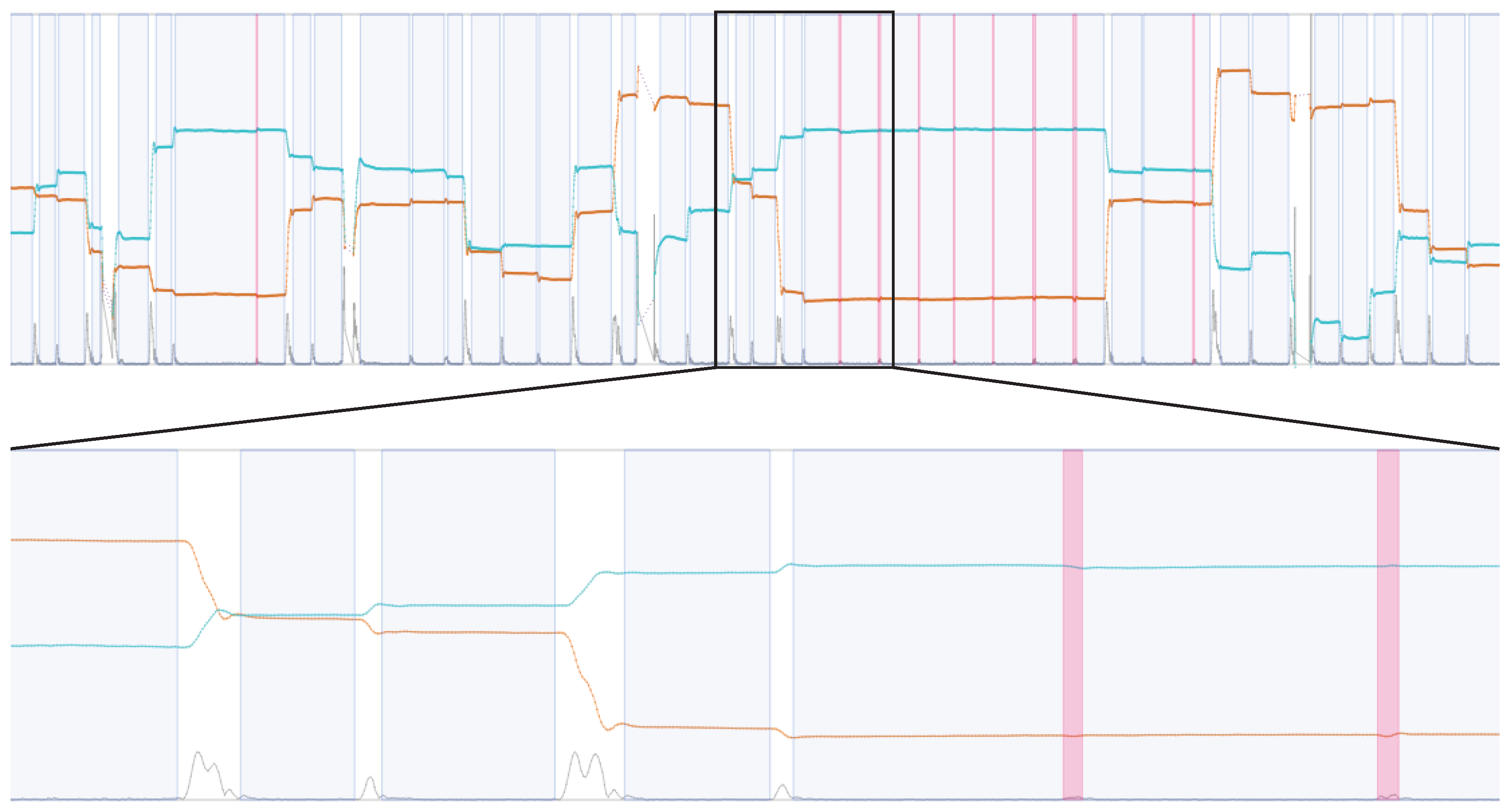
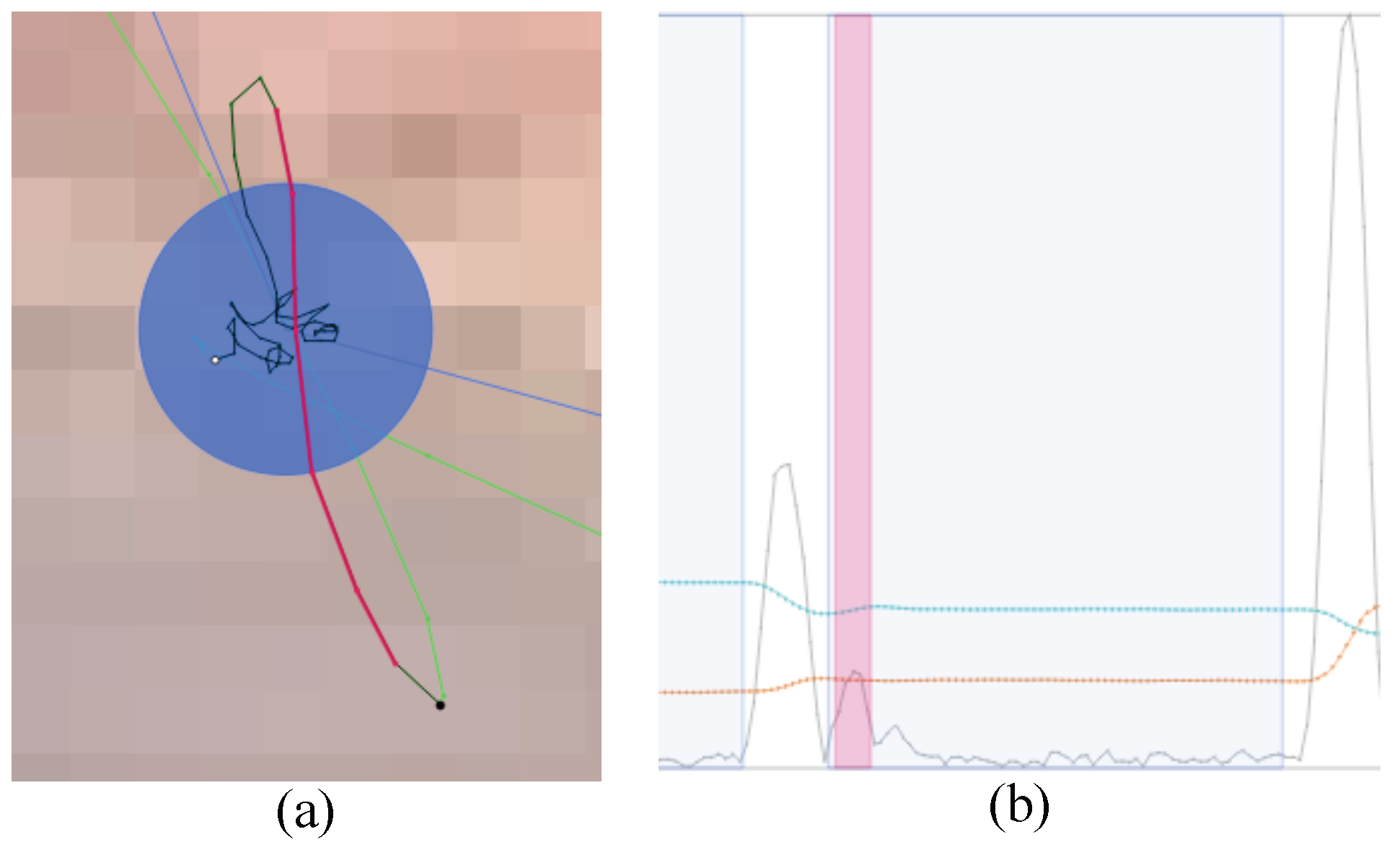
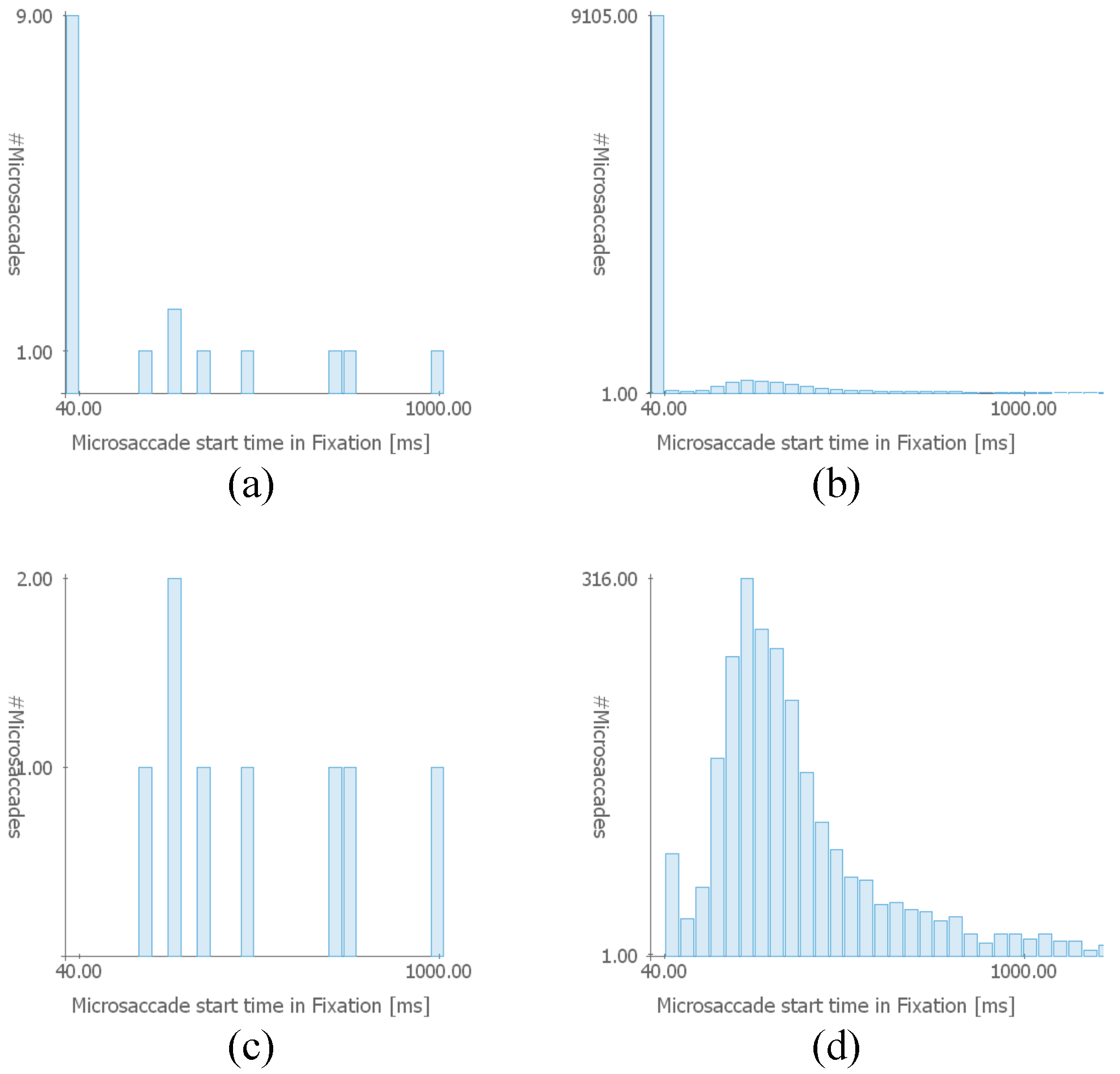
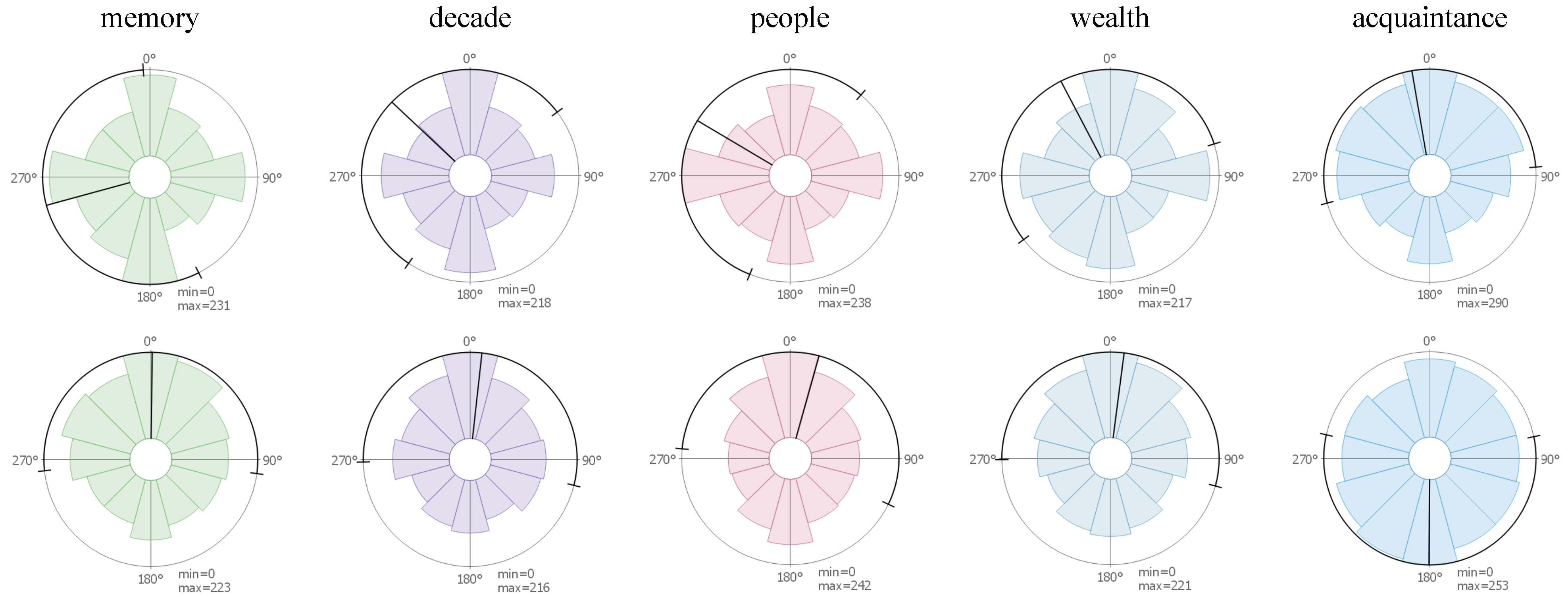

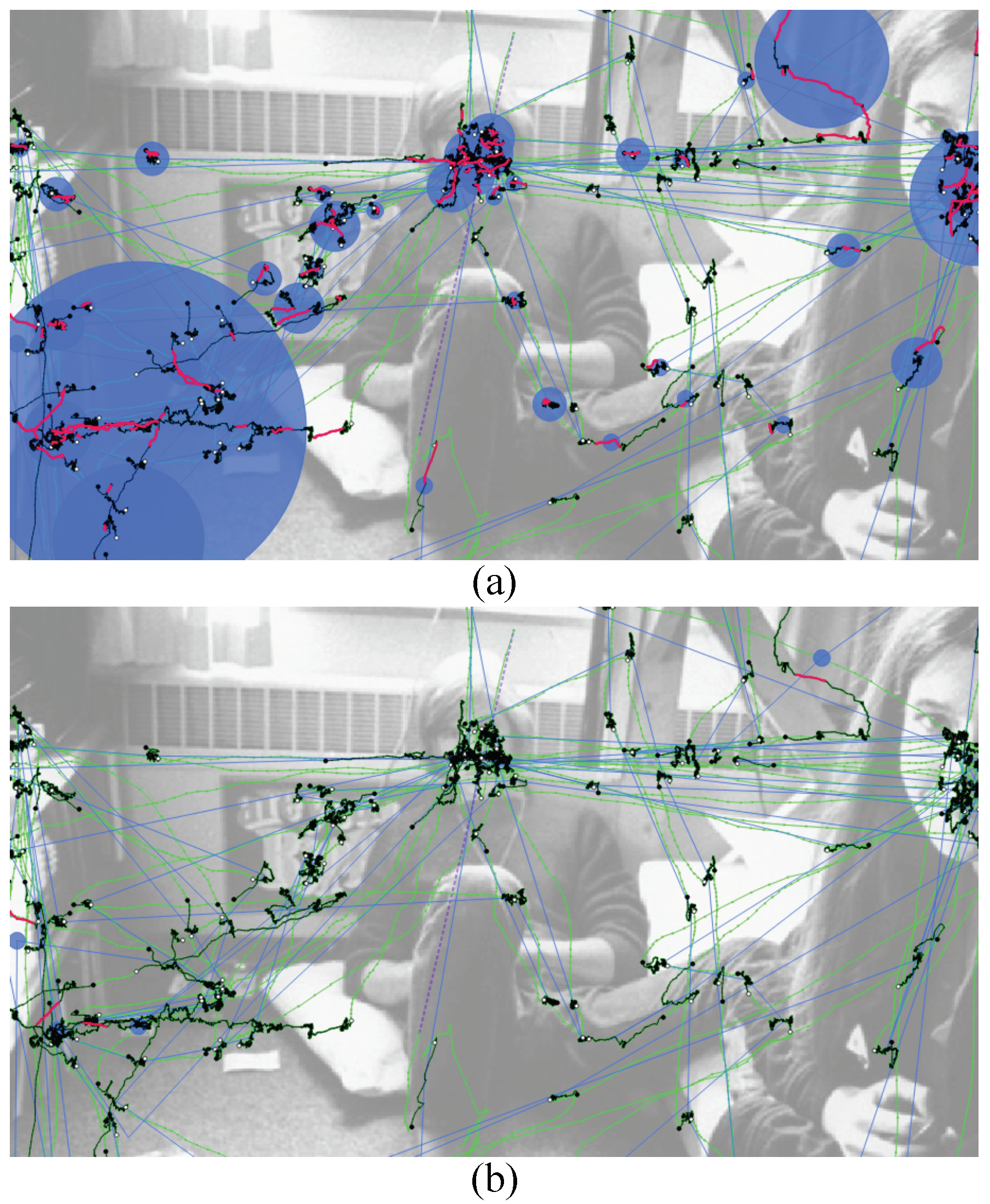

Copyright © 2019. This article is licensed under a Creative Commons Attribution 4.0 International License.
Share and Cite
Munz, T.; Chuang, L.; Pannasch, S.; Weiskopf, D. VisME: Visual Microsaccades Explorer. J. Eye Mov. Res. 2019, 12, 1-20. https://doi.org/10.16910/jemr.12.6.5
Munz T, Chuang L, Pannasch S, Weiskopf D. VisME: Visual Microsaccades Explorer. Journal of Eye Movement Research. 2019; 12(6):1-20. https://doi.org/10.16910/jemr.12.6.5
Chicago/Turabian StyleMunz, Tanja, Lewis Chuang, Sebastian Pannasch, and Daniel Weiskopf. 2019. "VisME: Visual Microsaccades Explorer" Journal of Eye Movement Research 12, no. 6: 1-20. https://doi.org/10.16910/jemr.12.6.5
APA StyleMunz, T., Chuang, L., Pannasch, S., & Weiskopf, D. (2019). VisME: Visual Microsaccades Explorer. Journal of Eye Movement Research, 12(6), 1-20. https://doi.org/10.16910/jemr.12.6.5



